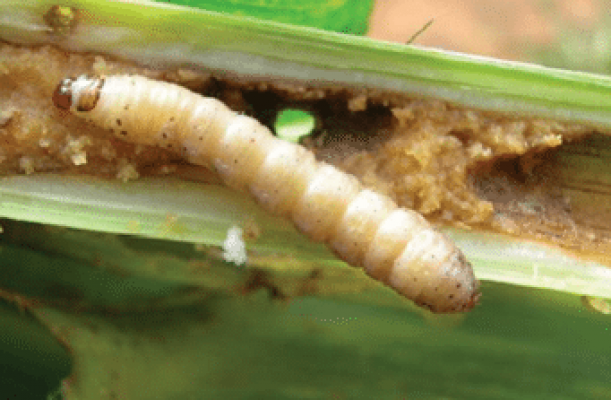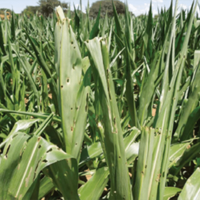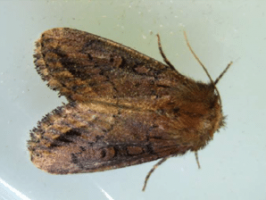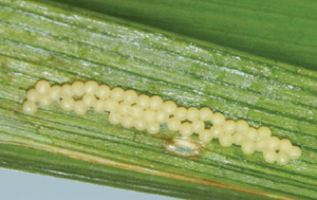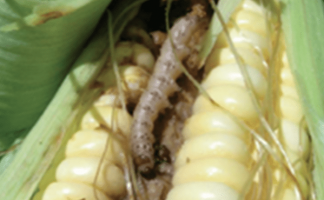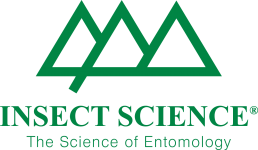Host plants
The host range of the maize stem borer is largely restricted to maize, millet, sorghum and sugarcane.
Damage
The first indication of damage is the appearance of small “windows” on the youngest whorl leaves. These symptoms result from larval feeding on the upper surface of the leaf, leaving the lower surface intact. As larvae grow, holes in the leaves become bigger until large numbers of holes appear (illustrated) or leaves take on a ragged appearance.
When infestation takes place at early plant growth stages, plants may develop dead heart symptoms. These symptoms are however not common in maize in southern Africa. Dead heart is caused when the growth point is killed by larval feeding and results in the wilting and drying of whorl leaves. When infestation occurs at later growth stages, typical whorl damage symptoms appear. Infestation at late plant growth stages may result in larval damage to maize ears (illustrated) and when larvae bore into stalks, stalk breakage can occur during strong winds. The maize stem borer is a chronic pest that can cause serious damage if it is not controlled.
Life history
Moths prefer to lay eggs on maize plants that are 4-6 weeks old. Eggs are laid in groups of 20-45 between the leaf sheaths and the stem of the plant. On older plants where maize ears are present, eggs may be laid below husk leaves. Although eggs may be laid during any plant development stage, the intensity of egg-laying declines with plant age. A single female can lay up to 900 eggs under laboratory conditions but the average number laid under field conditions is approximately 200-300. Depending on temperature, eggs take 5-9 days to hatch.
Immediately after hatching, larvae migrate to the whorl of the plant where they commence feeding deep inside the tightly folded furl leaves. Larvae also migrate between plants, especially during the first few days after the eggs hatch and again 2-3 weeks later when they leave the whorl of the plant to bore into the stem. Busseola fusca larvae feed in plant whorls for 10-20 days before they leave and enter the stems. They tunnel into the centre of the stalk where they feed until fully grown. Pupation, which takes place inside the tunnel, lasts for 2-3 weeks. The lifecycle of the maize stem borer is approximately nine weeks long.
Three distinct peaks in moth flights generally occur per season in the warmer western maize production region of South Africa. Due to lower temperature, only two flight peaks occur in the eastern Highveld region. The first and second generation moth flights peak around October/November and February respectively. A single maize planting is therefore usually attacked by either the first or the second generation, depending on planting date.
Larvae overwinter in the bases of maize stalks, below soil level, where they are protected from natural enemies and harsh environmental conditions. Stubble is therefore vital in the carry-over of stem borer populations from one season to another. During early spring after the first rains these diapause larvae change into pupae that give rise to first-generation moths.
Natural enemies
Many specialist and generalist natural enemies attack small larvae or consume stem borer eggs. In all, some 18 species belonging to eight different families of parasitic wasps have been recorded from southern Africa, as listen in Polaszek (1998). Of these, the braconid wasp Cotesia sesamiae (Cameron) and parasitic tachinid fly Sturmiopsis parasitica (Curran) are the most important natural enemies of this pest. On the Highveld of South Africa, larval parasitism of B. fusca is generally below 20% and occasionally reaches levels of 40-60%. In KwaZulu-Natal between 80-100% pupal parasitism of B. fusca may occur at certain times of the season. A comprehensive account of the natural enemies of cereal stem borers in Africa is given by Polaszek (1998).
Management
Various and diverse methods of managing B. fusca exist. The use of genetically modified (GM) Bt maize with insecticidal properties is the most important tool for stem borer control in maize in South Africa. Bt maize provided successful control of stem borers in maize until the appearance of resistant populations in 2006. This has been successfully counteracted by new generation Bt maize that employs two different Bt genes.
Chemical control by means of insecticidal sprays is also effective against stem borer larvae when they are still in the whorls of the plants. An action threshold value of 10% damaged plants per field is used as a guideline in determining when insecticides are used.
Cultural control practices include winter tillage and removal of volunteer plants. Stubble that remains in fields after harvest is the most important source of stem borer infestation during a subsequent season, since it provides overwintering sites for larvae. Removing and destroying stubble before planning is an effective practice, killing a large proportion of overwintering stem borer larvae. Ploughing or discing fields exposes larvae in stubble to predators and drastic temperature changes which may result in a higher mortality rate.
In East Africa and to a limited extent South Africa, habitat management practices such as the push-pull system, which makes use of trap cropping, has also been employed to control B. fusca. These habitat management practices are especially suited to small scale farming systems.

